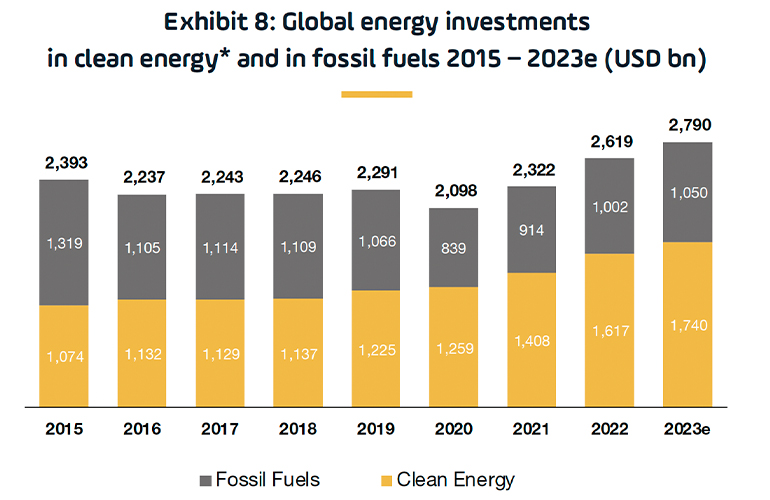Research by the Long-Term Infrastructure Investors Association (LTIIA), in partnership with the Global AWM & ESG Market Research Centre at PwC Luxembourg, predicts that 61 percent of investments in the global energy sector in 2023 will be directed towards renewable energy, nuclear power, EVs and improvements in energy efficiency.
Please reload the page
Do you want to read the whole article?
- Six editions per year
- 完全访问所有数字内容
- The E-magazine Bioenergy international
- And more ...
The recently published “Energy Transition: Implications for Infrastructure Investors“report integrates qualitative and quantitative research that reviews and analyzes the energy transition trends and their implications for institutional investors in infrastructure, both sector-wise and in terms of business models and allocation strategies.
The report also includes the findings of two surveys conducted with members of the LTIIA working group, encompassing asset owners, asset managers, and infrastructure service providers.
The energy transition, with its immense significance and far-reaching implications, stands as the linchpin in our collective efforts to combat climate change and forge a path toward a cleaner, greener, and more resilient world. It has come to the forefront of our collective consciousness in this pivotal moment, as it is one of the main resources at our disposal to significantly bring down greenhouse gas emissions and reach net zero by 2050. The world’s energy landscape must be reshaped urgently, as it is no longer just a policy option but a necessity, said Vincent Levita, Chair of the LTIIA.
The key data points from the report include:
- Increase in infrastructure funding by 18.5 percent. Between 2019 and 2022, there was an 18.5 percent increase in infrastructure assets under management (AuM), presenting a unique opportunity to channel more private investments towards sustainable projects that align with the energy transition.
- Since 2019, the share of fundraising by infrastructure funds linked totally or partially to renewable energy has grown to 92 percent, making up US$132 billion out of a global total for infrastructure funds of US$144 billion in 2022.
- The Energy Transition is increasingly addressed through the infrastructure lens: Between 2010 and 2022, the AuM of renewable energy funds skyrocketed from US$250 billion to US$1.261 trillion, growing at a CAGR of 14.4 percent. Infrastructure funds account for the lion’s share of such funds, with just under 75 percent of their total AuM in 2022.
- The vast majority of LTIIA survey respondents (83 percent) consider the energy transition to be part of their fiduciary duty, as well as a new investment opportunity.
Emerging risks yet to be reflected
The report highlights that, as the energy transition ramps up, renewable energy is taking on more risk than investors and lenders in infrastructure have historically assigned in terms of risk premium.
However, those emerging risks have yet to be reflected in the investors’ return requirements and their business models.
In this volatile environment marked by geopolitical conflicts, economic instability, and an increasing frequency of climate change-related disruptions, it is crucial to prioritize adaptability, innovation, and dedication to ESG principles. These factors are essential for bolstering the energy transition and actively participating in the energy transformation of the economy, Vincent Levita said.
The report also presents a set of recommendations for policymakers and governmental authorities, regulatory authorities, investors and asset owners, and fund managers.
The recommendations cover the need for roadmaps and commitments, public financial support when technology or market risks are too high, adapted sectoral and prudential regulations as well as enhancing technical and market expertise for Fund managers.
Beyond financing renewable energy ventures, investors can also contribute – particularly in social infrastructure – to educating end-users on the responsible management of their energy consumption.
By promoting better and smarter energy use, investors stand to improve their reputational risk and social license to operate, as well as achieve their financial objectives.
Despite the continuous growth in global infrastructure investments supporting the energy transition, net-zero goals remain challenging to attain, and we have yet to align with the necessary path to reach them. Governments cannot bear the financial burden of the energy transition on their own, making it even more crucial for the private sector to bridge the investment gaps. The growing awareness and prevailing emphasis on ESG considerations in the asset management sector is already making the energy transition the dominant global investment theme and preparing the ground for the required ramp-up, provided both public and private actors gear up to the challenge, said Francois Bergere, Executive Director at the LTIIA.




